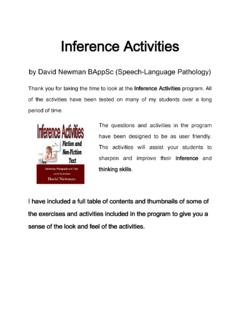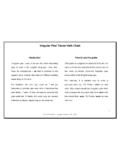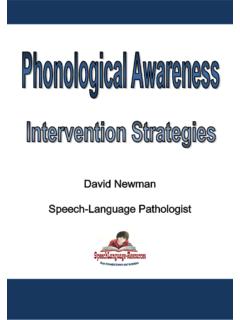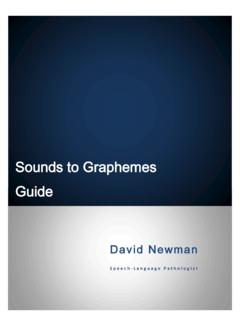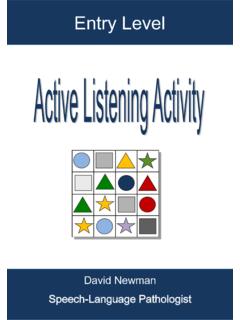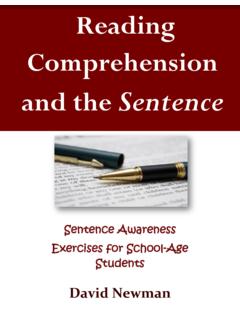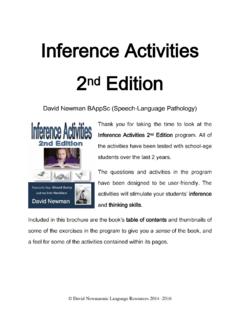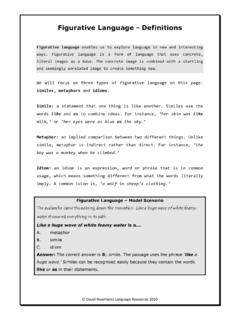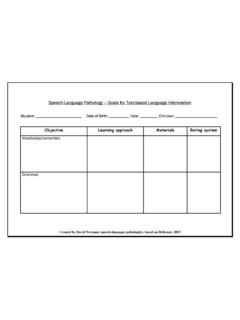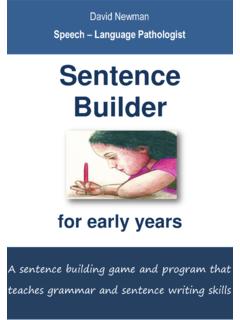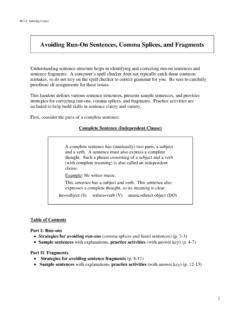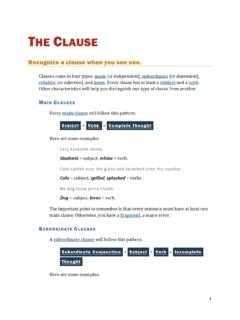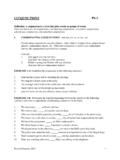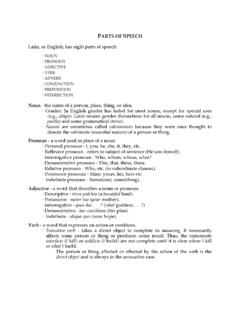Transcription of Language-Literacy Resources
1 1 Language-Literacy Resources 2 Language-Literacy Resources A Friendly Reminder This book and all its contents are intellectual property. No part of this publication may be stored in a retrieval system, transmitted or reproduced in any way, including but not limited to digital copying and printing without the prior agreement and written permission of the author. The Sentence Structure Program, all illustrations and graphic organizers created by David Newman, speech language pathologist 3 Language-Literacy Resources Table of Contents Chapter 1 (Introduction) .. 4 Chapter 2 (Identifying Sentence Types) .. 5 Simple Sentences Graphic Organizer .. 7 Simple Sentences Teaching Activity .. 8 Compound Sentences .. 9 Compound Sentences Graphic Organizer .. 10 Compound Sentences Teaching Activity.
2 11 Complex Sentences .. 12 Compound Sentences Graphic Organizer .. 14 Link Word Charts .. 15 Complex Sentences-Teaching Activity .. 17 Chapter 3 (Sentence Type Analogy) .. 18 Locomotive and Carriage Analogy .. 19 Locomotive Bolts Link Words .. 20 Embedded Clauses .. 23 Chapter 4 (Sentence Identification via fragment pieces) .. 24 Chapter 5 (Sentence Imitation via fragment pieces) .. 27 Chapter 6 (Unscrambling sentence fragments).. 33 Chapter 7 (Identifying Prepositional Phrases) .. 39 Chapter 8 (Using Prepositional Phrases) .. 42 Chapter 9 (Sentence Combining Activities) .. 46 Chapter 10 (Sentence Combining Activities Complex Sentences) .. 52 Chapter 11 (Expanding Sentences with Adverbial and Adjectival Clauses) .. 61 Chapter 12 (Shuffling Clauses) .. 68 References .. 75 Appendix A: Answer Section.
3 77 Appendix B: Cut out Clauses .. 88 4 Language-Literacy Resources Introduction entences are the building blocks of language in both spoken and written language. When we communicate our ideas we structure them into sentences, which is a meaningful unit of language. Sentences communicate complete thoughts. How we use sentences in spoken language differs from how we use sentences in written language. In spoken language we use our voice and a rapid rising and falling intonation. We also use pause between sentences to communicate ideas. We use body language such as gesture, facial expression and eye contact to support our words. In written communication, the process is a little different. Written language uses more formal processes such as capital letters at the start of sentences and full stops at the end.
4 All dialogue is contained within speech marks, etc. Sentence Combining Program The sentence combining program is focused on students being able to write complex sentences with confidence. Many students find it difficult to write sentences with any confidence or effectively. Part of the problem is that students have poor understanding of sentence construction. They also fail to recognize or have an appreciation for the different sentence types and how to structure sentences in a creative way. If students have difficulty writing effectively about new concepts or information they ve learned, or struggle to create written stories, then they may never fully realize their academic abilities and may always struggle in school. This may limit their potential to transform their thoughts and creative expression into the written form.
5 In the sentence combining program, students will be taught to recognise the structure of the various sentences types and will learn ways to recognise and manipulate clauses to eventually create their own original simple sentences and then progress to compound and complex sentences. S 5 Language-Literacy Resources Identifying Sentence Types Purposes _____ i. Provide information on the various sentences types (simple, compound, complex) and how to recognise them in text, and to understand the function of clauses. ii. Provide graphic organizers that demonstrate, in clear detail, the structure of the various sentence types and how they differ from each other. iii. Explain the role of the various sentence types and how writers use them to communicate ideas and the role of coordinating and subordinating conjunctions.
6 Iv. Explore through a range of activities how to identify the differences between simple, compound, and complex sentence types. Lesson 1: Simple Sentences Definition: A simple sentence consists of a single main ( independent ) clause. A main clause can be thought of as being a complete and meaningful unit of language. Teacher script: A simple sentence is essentially a main clause. A simple sentence is also known as an independent clause, and has a basic structure of subject and predicate. Another way to define a simple sentence is that it is a complete thought. It must always contain a subject and verb, and often includes an object. A simple sentence must have at least one verb. For example, on the table is a phrase and not a complete thought, whereas I sat on the table is a complete thought and is in fact a complete sentence, because it contains the subject I the verb sat and the object on the table.
7 A simple sentence has one clause only. If you ever get stuck remembering how a basic sentence is constructed, and how it s different from other sentence types, remember that a simple sentence contains a single clause. The main ( independent clause) clause can either be quite short, or very long. The simple sentence, though it only has one main clause, can reach a great length due to 6 Language-Literacy Resources the author adding phrases. Phrases are groups of words that do not contain a verb. Phrases are only part of a sentence. For instance, these combinations are all phrases: big eyes, long furry tails, with long tails, etc. So if we were to expand that idea with the simple sentence, The boy ran, we could add modifiers such as adjectives, adverbs, and noun phrases.
8 But here s the thing, despite the sentence reaching a ridiculous length, it is still only a simple sentence because it only has a single verb ran. The boy ran. (simple sentence) The boy ran quickly. (adverb added) The boy with the blue jeans (adjectival phrase) ran quickly. The boy with the blue jeans ran quickly to the store (prepositional phrase). On a hot summer s day, (adjectival phrase) the boy with the blue jeans ran quickly to the store. The important thing to note here is that, as we can see with the boy ran sentence example, simple sentences can be very short. A famous example is Jesus wept. However, as we can also see from our on a hot summer example, a simple sentence can also be very long. The length of a sentence offers no real clue as to whether a sentence is simple, compound or complex.
9 The essential thing to look for in identifying simple sentences is, does it contain a verb, and is it a complete thought? On the following page is a graphic organizer that gives an overview of the structure of the simple sentence. Take note of its Language-Literacy Resources Simple Sentence A sentence ( independent clause) expresses a complete thought. A simple sentence contains a subject, a verb, and often, but not always, an object. A written sentence starts with a capital letter (A), and ends with either a full stop (.), question mark (?), or exclamation mark (!). Verb: Verbs are essential in a sentence. Every simple sentence must have a verb. Subject: The subject is the noun or pronoun. Object: The noun or pronoun to which the action of the verb is being done. Examples Subject Verb Object The boys (noun) are swimming (aux verb & verb) in the water (prep phrase) The horse (noun) ran (irregular past tense verb) to the gate.
10 (prep phrase) 8 Language-Literacy Resources Teaching Definition: subject who or what the sentence is about. A kind lady stirred the soup. Definition: verb - a word or words that tell us what is going on in a sentence or an aspect of being. For instance, A kind lady stirred the soup. Paula is reading a book. The dog should have caught the ball. Identify the subject and verb in the simple sentences below. Circle the subject and underline the verb. The first one is done for you. 1. 2. The weather is hot and stuffy. 3. The telephone was ringing. 4. The large book was a dictionary. 5. Cool blue water flowed through the canyon. 6. Two cute puppies ate from the dish. 7. At dawn the sun rose in the sky. 8. A really nice old lady lives in the big house. 9. Three girls sat in the cafe.
